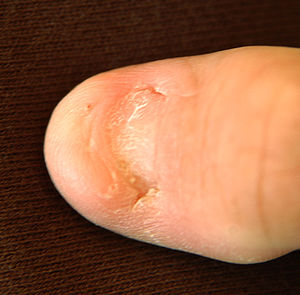Nail patella syndrome
| Nail–patella syndrome | |
|---|---|
 |
|
| Nail of a patient with nail–patella syndrome | |
| Classification and external resources | |
| Specialty | medical genetics |
| ICD-10 | Q87.2 (ILDS Q87.230) |
| ICD-9-CM | 756.89 |
| OMIM | 161200 |
| DiseasesDB | 8773 |
| eMedicine | ped/1546 derm/813 |
| MeSH | C05.550.629 |
| Orphanet | 2614 |
Nail–patella syndrome (NPS) (also known as "HOOD syndrome") is a genetic disorder that results in small, poorly developed nails and kneecaps, but can also affect many other areas of the body, such as the elbows, chest, and hips. The name "nail–patella" can be very misleading because the syndrome often affects many other areas of the body, including even the production of certain proteins. Those affected by NPS may have one or more affected areas of the body, and its severity varies depending on the individual. It is also referred to as iliac horn syndrome, hereditary onychoosteodysplasia (HOOD syndrome), Fong disease or Turner–Kieser syndrome.
Diagnosis of NPS can be made at birth, but is common for it to remain undiagnosed for several generations. While there is no cure available for NPS, treatment is available and recommended.
The skeletal structures of individuals who have this disorder may have pronounced deformities. As reported by several medical doctors, the following features are commonly found in people who suffer from nail–patella syndrome:
Bones and joints
An elbow of a man who suffers from nail–patella syndrome (NPS)
This is a view from a different angle of the same man's other elbow
Kidney issues may arise such as proteinuria and nephritis. Proteinuria is usually the first sign of renal involvement and either rapidly or years after suffering from asymptomatic proteinuria, renal failure occurs in around 5% of NPS patients. Hypothyroidism, irritable bowel syndrome, attention deficit hyperactivity disorder (ADHD), and thin tooth enamel are associated with NPS, but whether these are related or simply coincidences are unclear.
The Nail–patella syndrome is inherited via autosomal dominancy linked to aberrancy on human chromosome 9's q arm (the longer arm), 9q34. This autosomal dominancy means that only a single copy, instead of both, is sufficient for the disorder to be expressed in the offspring, meaning the chance of getting the disorder from an affected heterozygous parent is 50%. The frequency of the occurrence is 1/50,000. The disorder is linked to the ABO blood group locus.
...
Wikipedia
